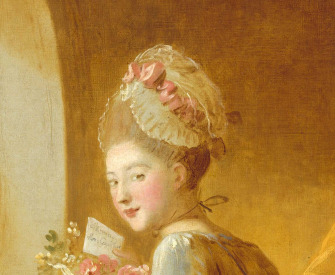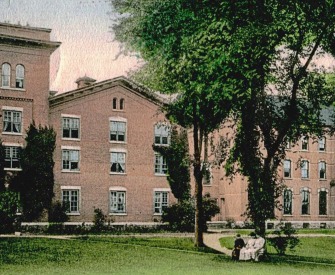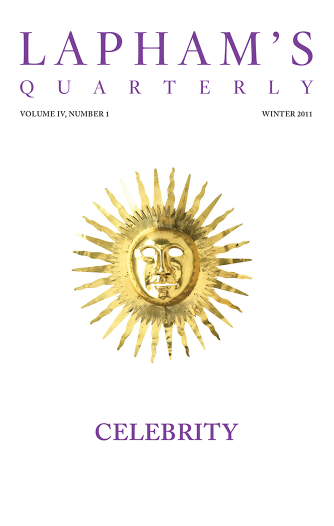To be a successful father… there’s one absolute rule: when you have a kid, don’t look at it for the first two years.
—Ernest Hemingway, 1954Working Arrangement
Marriage as we know it today is a very recent invention—one that has very little in common with the unions of old.
By Justin Smith-Ruiu

The Arnolfini Marriage, by Jan van Eyck, 1434. National Gallery, London.
Whether to denounce it as a step down the path to unspeakable decadence or to exalt it as self-evidently right and just, everyone in public life today has a position on gay marriage. All the presidential candidates in the current electoral cycle have been asked about it, and all have had responses carefully packaged to ingratiate themselves with their constituencies. If the past few years may serve as a guide, it is likely that in the coming elections the subtle middle will be thoroughly excluded, as candidates and voters alike flock to one of two opposite poles: either holding that “marriage is between a man and a woman,” or, on the contrary, that everyone has an equal right to marriage. These are thought-arresting platitudes; they are not articulate positions, nor even the rudiments of arguments for such positions. The greatest problem with both is their brash confidence in the moral abhorrence or necessity of gay marriage, absent any historical or critical interest in the nature of marriage itself.
The rise of gay marriage, I believe, has played an important role in reinforcing naturalism about marriage, and thus in buttressing the conservative cause, at just that moment in history—the decades following the sexual revolution—when the contingency of marriage began to show through and its role as the basic building block of society came to be called into question. Pervading the arguments for marriage equality made by eloquent defenders such as Andrew Sullivan is the idea that gay marriage will not, as the conservatives fear, cause us to lose our moral bearings, so much as it will bring gays into the fold of a single gay-straight community of shared moral values. Over the past fifteen years, the liberal mainstream has begun to move toward this view. But Sullivan is, in the end, a conservative himself, and it is one of the great wonders of the past few decades of public debate that his conservative argument has won over so many who otherwise despise this political orientation. The same people who claim to dislike talk of family values will defend gay marriage on the grounds that it contributes to the strengthening of those values.
I came of age after the so-called sexual revolution. In 1972, the year I was born, lemminglike followers of popular trends were lining up in front of mainstream cinemas, not to see La Dolce Vita as they would have just a decade earlier, but rather Deep Throat. When I was seven or so, I struggled to make sense out of adult chatter, on visits to nearby San Francisco, about openly gay politician Harvey Milk, and about the goings-on on Polk Street (the prospect of getting “poked” on Polk Street was a stupid running joke of my cohort of Central Valley children). The year my parents’ marriage failed, in 1981, two decades or so after the debut of Betty Friedan’s The Feminine Mystique and nearly a decade after Deep Throat, represented the statistical peak of the U.S. divorce rate. So unlike, say, my coevals in the communist world, I was well aware by the early 1980s of both the existence of same-sex sex, as well as of a severe crisis in the history of marriage. But it would be a long while yet before I would be able to think about these two things in connection with one another.
One memory in particular serves to illustrate the conceptual distance in my mind at that time between marriage and same-sex love. I don’t know quite how old I was, but I know the home-video revolution had already occurred. We had a Betamax, and we were in the video store. There was not much to choose from, but one cardboard box on display jumped right out at me: it was The Gay Divorcee, a 1934 vehicle for the immortal Fred Astaire and Ginger Rogers. Now I saw this videotape’s cover at an age when I still heard an imaginary adjective, “donserly,” modifying “light” toward the beginning of our national anthem, and I believed that “atlas” was a sort of contraction between “at last” and “alas.” In short, there were a lot of things I was still getting wrong. Yet there is something telling, isn’t there, in the way children get things wrong? I assumed that Fred Astaire had starred in a movie depicting a topsy-turvy world, a world in reverse, much like a Rabelaisian carnival: one in which, of all crazy things, homosexuals could marry and divorce. I came of age at a time when “gay” could no longer mean what it had meant for Fred Astaire, but also when gay marriage, and by natural extension gay divorce, remained, at least in the tract houses of central California, the stuff of counterfactual Hollywood tales. Marriage remained heterosexual by definition, and was at this point unhappy by implication. The curtains had been drawn back on marriage, and the tedium, hypocrisy, and deceit at the heart of the institution exposed. “Gay” no longer only meant “happy,” and there was nothing happy anymore about marriage: two facts which together made the ground ideally fertile for the rise of what we now call “gay marriage.”
The nuclear family is a recent invention. As an arrangement that, ideally, isolates a man, woman, and a few children within a single, economically autonomous domestic unit, with only casual or symbolic ties to friends and extended family, it does not seem to predate the Industrial Revolution and the rapid urbanization that followed it. Indeed, the expectation that everyone should find a place in such an arrangement appears to be Fordist in origin: the same vision of the future that caused us to believe that everyone might have a place in a system of production, might commute to it in an automobile, and might return home at the end of the day to a freestanding domicile with a family inside. Gay marriage, accompanied in the developed world by the shining new apparatus of reproductive technology, is but the latest tweaking of this new development. In this respect, relative to the great majority of marriages throughout human history, gay marriage is not really marriage, but then neither is first-world, individualistic, freely chosen heterosexual marriage. Marriage was for most of human history a variety of exchange, one that consolidated social ties between families or clans. When a young man of the Nuer tribe is initiated, he receives cattle that he will care for his entire life and will trade for certain goods, including a wife. When the men give the cattle, it is understood that they are giving a part of themselves, and their newly-swapped spouse becomes an essential part of their lives and their lineage. In his monumental work The Elementary Structures of Kinship, which first appeared in French in 1949, Claude Lévi-Strauss argued that marriage is not first and foremost a sentimental union between two individual people, but rather a union resulting from exchange between two families. For the great structural anthropologist, human society emerges when, driven by the incest taboo, early human families enter into relations of credit and debt with their neighbors as they exchange their nubile women, and as exchanged daughters are transformed into wives. Women, in Lévi-Strauss’ account, are thus basic units of social exchange, a view which would be seen as very inadequate by his feminist successors in the structuralist school, such as Françoise Héritier, who argued that what in fact is going on is the masculine appropriation of the reproductive capacities of women. But whether or not early human societies were really so misogynistic as to see their daughters as mere commodities, it is difficult to deny the basic insight that, historically, marriage has mostly had to do with the maintenance of society through the consolidation of interfamilial bonds.
Now this may seem like a bleak and reductive picture of what marriage is about, yet it quickly appears as a picture of a veritable golden age when we turn our attention to what marriage has become. For it is not so much that what was once seen as an economic exchange has been transformed in the modern era into a matter that is more often of the heart. Rather, if the oblivious newlyweds in traditional marriages were themselves the units of exchange, today, by contrast, in the bourgeois nuclear family, couples fulfill the role not of society’s basic units of exchange, but rather of economic production.
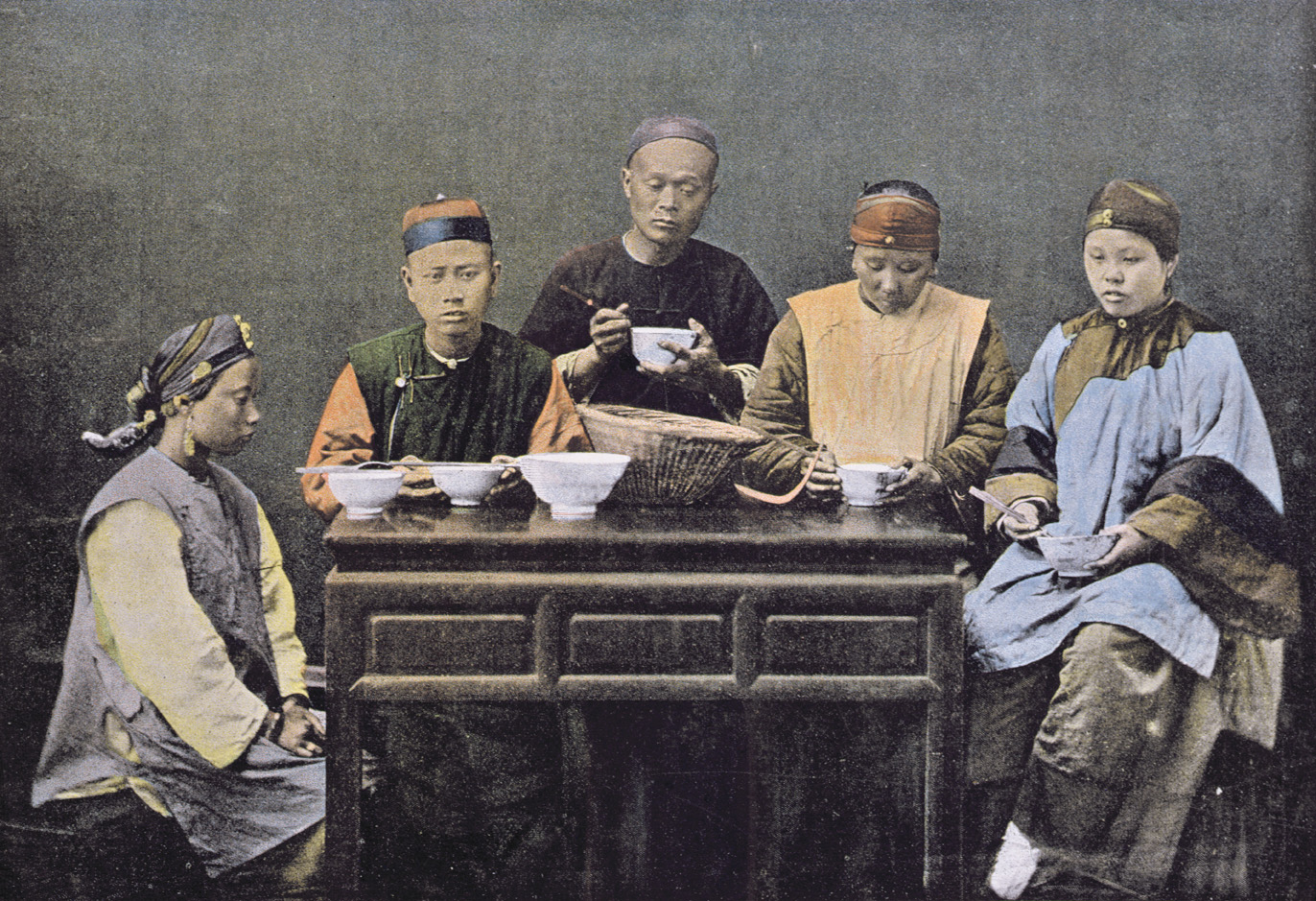
Family having a meal, China, c. 1900. © Bibliotheque des Arts Decoratifs, Paris, Archives Charmet, The Bridgeman Art Library International.
Of course, households have always been loci of such production, but the modern era brought with it an increasing awareness of the economic character of spheres of life that earlier had been not work, but rather simply what one does. Thus, first, the market itself came into existence, or was discovered (depending on how you see things), and over time came to engulf virtually all domains of human activity. Today, we understand not just factory work or ditch digging to be labor in the proper sense, but also eldercare, babysitting, clothes washing, and child rearing. This is in one sense certainly right: there is no justifiable categorical difference between the sort of labor once glorified by Marx—dirty, manly, soot-soaked labor—and the kind that goes on in the home. But if everything is now conceptualized as labor, this generality of it makes extremely hard the task of imagining ourselves into a world where nothing was so conceptualized. Prehistoric hunter-gatherers did not think of fishing or berry picking as “a good line of work” or a bad line. It was just what one did. So while it is worth abandoning the false dichotomy between Marx’s preferred varieties of work and what goes on in the domestic setting, one might still regret that anything at all in human life should have come to be seen as work: as something that is taken away from us, and for which we deserve to be compensated.
It will not be controversial to point out that until the past two hundred years or so, there simply was no presumption that marriage should be motivated or sustained by love. In fact, many premodern authors took it to be a sort of category mistake to love one’s wife in the same way, with the same passion, that one might love a lover. St. Jerome attempted to correct the category mistake in his Adversus Jovinianum of 393 as follows: “Men should appear before their wives not as lovers but as husbands.” One problem with passionate love toward a spouse is that this is simply impossible to sustain, yet marriage is, or long was, a lifetime commitment by definition. Thus many skeptics well into the modern era continued to highlight the categorical impossibility of the sort of conjugal love the modern world had come to hold up as an ideal. As George Bernard Shaw would claim in his 1908 comedy Getting Married, this new conception of marriage based in passionate love requires two people to promise to remain in an “excited, abnormal, and exhausting condition continuously until death do them part.”
What is more difficult to understand, and what seems to invite only controversial theses, is the question of why the conception of marriage as love, on the one hand, and as work on the other, emerged together in the modern era. Some have argued that it was precisely the expectation that marriage should be sustained by love that brought the institution to a crisis, and brought us to a situation more absurd than Shaw could have imagined, where couples are expected to work in order to preserve themselves in the exhausting and abnormal condition in which they started out. Stephanie Coontz argues in her popular 2005 book, Marriage, a History, that “although many Europeans and Americans found tremendous joy in building their relationships around these values, the adoption of these unprecedented goals for marriage had unanticipated and revolutionary consequences that have since come to threaten the stability of the entire institution.” Love, on this account, gives way to work, as the feeling of love, but not the expectation of it, declines over the course of a couple’s life. Today, metaphors of work abound in the way we speak of marriage. We are even led to believe by therapists and their parrots that marriage itself just is work, and that when it goes sour it is because we are not working hard enough.
Yet one may wonder, pace Coontz, whether there is not an even more intimate connection between love and work than the one where work moves in to try to restore or preserve what is left of a fading love. One might suppose rather that love and work—or at least a distinctly modern, capitalist conception of work—are two sides of the same coin: both emerge together at the same moment in history, and both carry with them the ungrounded belief that each of us has our destiny in our own hands, that our happiness is entirely a consequence of our life choices, and our misery a surefire sign that we are doing something wrong. In this connection the contemporary use of “passion” serves as a revealing misnomer. For how many can recall that, originally, from classical antiquity through Descartes’ The Passions of the Soul, to undergo a passion was to suffer an affliction over which one had no control? To undergo a passion was to be on the receiving end of an action, to be a patient rather than an agent, and in this respect the idea of choosing to live a life of passion, to “follow one’s passion,” could have made no sense. But in the modern world, in both work and love, this is precisely what we are expected to do: to treat the things that happen to us, that cannot but happen to us, as a result of the way our society is structured, as if they were the result of our own sundry projects of self-creation.
As the family goes, so goes the nation and so goes the whole world in which we live.
—Pope John Paul II, 1986The rebranding of couples as “partners” is the sad culmination of the modern transformation of couples into work-love units. Heterosexual couples began calling one another “partners” at some point in the late 1980s or early ’90s out of a sense of solidarity with their gay friends who could not yet be spouses. Believing themselves to be friends of sexual otherness, they were at the same time abetting the ongoing transformation of marriage into a variety of modern capitalist work. And it is at precisely this moment in the history of marriage that it became feasible for the institution to subsume same-sex couples: the moment at which the hard work of individuals had fully replaced exchange between families as the basic model of what a marriage ought to be. One recalls for example the scene from the 1999 film American Beauty in which the gay neighbors ring the doorbell of Col. Frank Fitts, an abusive ex-marine and collector of Nazi paraphernalia. “Let’s cut to the chase,” Fitts blurts out, “what are you guys selling?” They explain that they just wanted to welcome him to the neighborhood. “But you said you’re partners,” he replies, “so what’s your business?” And so the partners present one another: “Well, he’s a tax attorney.” “And he’s an anesthesiologist.” This, the audience understands, is the “new normal”: the same-sex couple, having embraced the model of coupledom as partnership, represents the neighborhood, the domicile, and the good career; the man who cannot comprehend this model is a closet Nazi.
When marriage was a matter of exchange, the gender of the units of exchange was a nonnegligible factor in the determination of who should be exchanged with whom. A family simply could not afford to give its son to a fruitless union with another family’s son. When marriage comes to be seen as a line of work, by contrast, and when individuals are seen as free to choose their own vocation, then it correspondingly transforms into a gender-neutral institution. It is thus exactly the historical moment when marriage becomes a variety of work rather than of exchange that the genders of its members cease to matter. Marriage was always an economic matter, but members of marriages were not always its employees, and this is what the awful new talk of “partnership” is really about.
In the end, perhaps the only question that really matters is whether the new marriage employees are happier than the old units of marital exchange. It is of course difficult to take the measure of premodern happiness, but one thing of which we may be fairly sure is that no one of any social class nor, evidently, of any culture, ever placed any significant portion of their hopes for happiness in life in the work of marriage, for marriage was not yet work. Certainly, countless young people throughout the generations have hoped and prayed that fortune would shine on them and they would be blessed with a rich, strong husband, or with a buxom, fertile wife. But this was a question of fortune, not of work, and if one ended up with a lout or a hag for a spouse, this seems to have been interpreted mostly as a matter of fickle fortune, not the mark of an underdeveloped work ethic.
Where then was happiness? In lovers, in extended family, in nature, in God. Today, by contrast, there is an expectation that a stable partnership must be a sine qua non of happiness in general, that if happiness is not flowing from the work of marriage, a life cannot be said to be happy at all. But such happiness is never less precarious than a 401k, and in a world in which marriage is a sort of work, and in which work is conceived as something that we variously succeed or fail at depending on the strength of our characters and the rectitude of our choices—in such a world it is no wonder we find so many people who believe they have, themselves, failed to attain happiness.
And again, it is at just this stage that gay marriage comes to seem such a hopeful thing: marriage, that is, of the people whose very categorization derives from that state of the soul that seems constantly out of the reach of straight married couples. Perhaps, the thought seems to have been, the synecdoche can be transferred, and the advent of gay marriage will usher in a bright new era of happy marriage. But what this thought might miss is that it was precisely same-sex desire’s position outside of the marital work-unit—in a word, gay freedom—that made the label “gay” seem so fitting in the first place.
Gay love, gay sex, and gay relationships used to be countercultural, subversive, and explicitly noncapitalistic. Although not always the rebellious and even criminal act that it was for centuries, gay love has always stood on the margins of the economic contract that is heterosexual marriage. Gay love and sex force us to see another way of being, and history is ripe with examples. There is paiderastia, a fundamentally unequal relationship, a nonpartnership, in which a younger man played bottom to an older man’s top, in the classic pair of contrasting roles of erastes and eromenos, the lover and the beloved. There is the Byzantine institution of adelphopoiesis, literally, “brother making,” which was a sort of spiritual marriage between two men, though which gives us very little evidence of the thing our simultaneously prudish and prurient age takes to be the singular marker of the erotic. And outside of these and other complex institutions through which history leaves us traces, there is always, of course, that broad buffet of sexual activities that was long designated not by a Greek term but by a name deriving from an Old Testament city destroyed by God in his wrath: sodomy, which Michel Foucault famously argued was a mere form of behavior before it was medicalized and essentialized in the nineteenth century into a type of person—the sexual deviant. Without deprecation, we may qualify the forms of expression for gay desire that were available in the West from at least the late Middle Ages until the past few decades as decidedly sodomitical. The bathhouse, the nightclub, the urban park at night: all exist as social spaces where the ordinary bonds and long-term commitments of “real” lives are suspended.
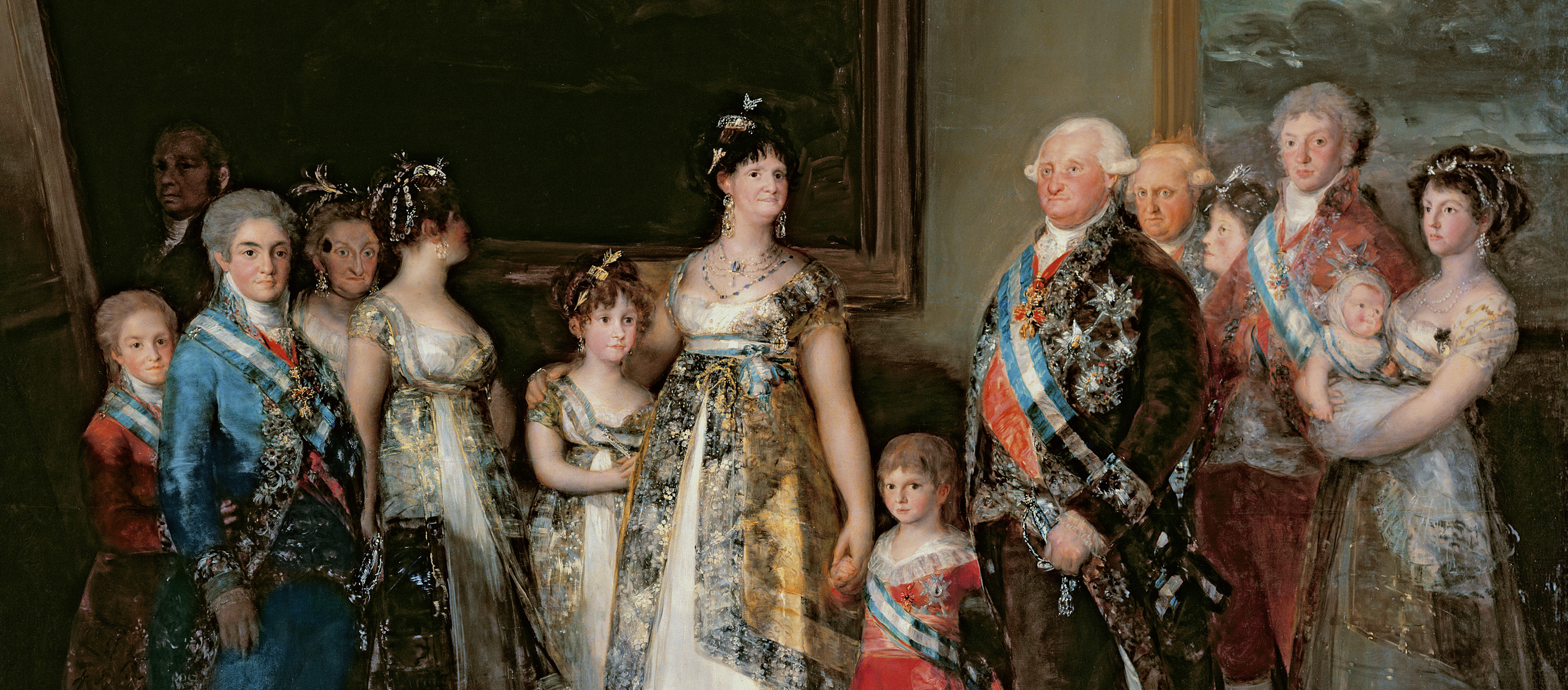
Charles IV and His Family, by Francisco José de Goya y Lucientes, 1800. Prado Museum, Madrid.
A century ago it still made sense for a poet such as Stefan George, no stranger to same-sex desire, to express his desire in terms that acknowledged the fragility of eros, a fragility that can’t but couple it, eternally, to death. George’s young lover, in the Star of the Covenant of 1914, is memorialized in the fleeting instant between orgasm and combat:
He tempts no more, has no jewels. Shines with grit and lust for battle.
His look…his kiss is short and burning.
His seed now shot from the holy shaft.
He pushes into pain and danger.
There was no AIDS virus to drive the point home, but there was a looming world war, and in the era, the eroticization of the precariousness into which the war’s violence brought male bodies seems to have rested on an intuitive association, one that enables us to make out a lost sphere of experience, of impure love and haunted passion, of pain and danger, and of a sort of holiness. Modern marriage some time ago succeeded in neutralizing these forces in the realm of heterosexual desire, and over the past twenty-five years or so, they have, through the expansion of the kinship system, finally been routed from their last bastion. Marriage, in dire crisis just a generation ago, has moved into its imperialist stage.
To see gay marriage as a blow to the august institution of marriage, then, is to fail to take into account the fact that the institution as we know it is a very recent invention. Marriage was already blown apart, or at least completely broken off from its traditional role, with the rise of the nuclear family. In this respect, gay marriage is not a reduction to absurdity of an ancient institution, so much as it is an instance of late capitalism’s voracious absorption of everything that might otherwise stand as an obstacle to it. Just as society has learned to absorb countercultural signifiers into advertising for the junk that must be hocked in order for capitalism to survive, just as the big oil companies have cultivated the ingenious art of “greenwashing” and incorporated eco-babble into their own PR campaigns—so too has bourgeois marriage absorbed what was left of the sexual opposition.
Certainly, there were always members of the gay community who would rather not have borne the burden of existential difference, who would rather have stayed who they were while seeing society change in such a way that who they are might be allowed to count as normal. The domestication of same-sex desire is surely a good thing for these people. But their individual advantage does not mean that the world as a whole is not losing something, and it has been one of the great fallacies of the liberal defenders of gay marriage to assume that what is good for any given individual is for that very reason good for society. The loss we have in fact suffered is one akin to the loss of some mighty species of wild boar as it is bred downward into a fat, ugly, lazy, edible pig; or to the move of indigenous Amazonians from the rainforest into squalid urban slums. In each case, one may insist that the absorption of these once-free beings into the dominant world order is a bit of progress for them: the pigs will now be well fed (until they are slaughtered), and the proletarianized Indians will eventually benefit from some small dose of welfare-state largesse. But in each case there is something the world is losing. With the right to marry granted, gay couples will visit each other in the hospital and will get in on the system of inheritance that is the very bedrock of the sedentist system that has in much of the world been held, since the Bronze Age, to be of higher status than nomadism or pastoralism, and that since the rise of capitalism has been practically imposed in all corners of the globe.
The thing that impresses me most about America is the way parents obey their children.
—Edward, Duke of Windsor, 1957Why this now, and not some other thing? What are the circumstances in which this particular social change is not only demanded but comes to be seen as having universal validity, comes even to be spoken of in the language of human rights? And here the answer seems unavoidably to do with the utility of the domestication of gayness, at a historical moment when marriage, if reserved for the straight alone, seems on its way to extinction, and at a moment when the consumerist status quo is growing rapidly more sophisticated in its strategies for co-opting any social force—whether political, musical, artistic, sexual—that had hitherto lay outside it.
We are not supposed to speak anymore of the connection between same-sex desire and creativity. We are expected to understand that every sexual orientation features characters of all kinds, that sexual others are “just like us” in every respect save for their sexual otherness. Yet the historical connection is undeniable, and in order to acknowledge this we do not have to mire ourselves in spurious speculation about the proximity of the “gay gene” to the “artist gene” in the human chromosome. Creativity itself was a structural feature of the place of the sexual minority in society. One can with perfect consistency, again, rejoice at the disappearance of gay marginalization, and at the same time bemoan the cultural cost of this.
And in truth we have not ceased to expect creativity from gay men; we have simply lowered our standard of taste. Where we once desired art that shook the very foundations of our society, that faced up to pain and danger as raw facts of our existential predicament, we now yearn for interior decoration that pleases the very most conventional heterosexual sensibilities. Indeed, is the recent, familiar casting of the gay man in the role of interior decorator not a perfect illustration of the process of domestication we are lamenting here? Where we once had art that threatened to tear down the home and the conventional values it harbors, we now have men offering to spruce that same home up for us, to make it more livable, again, to do what can be done to make marriage gay again.
